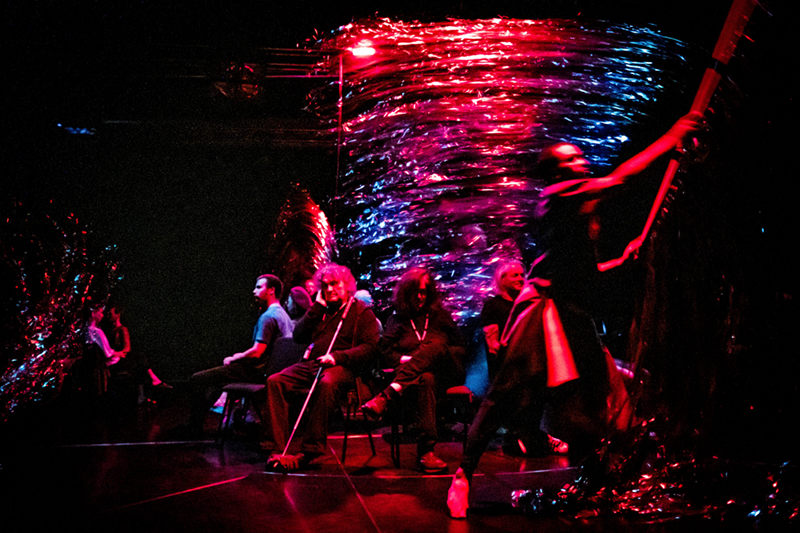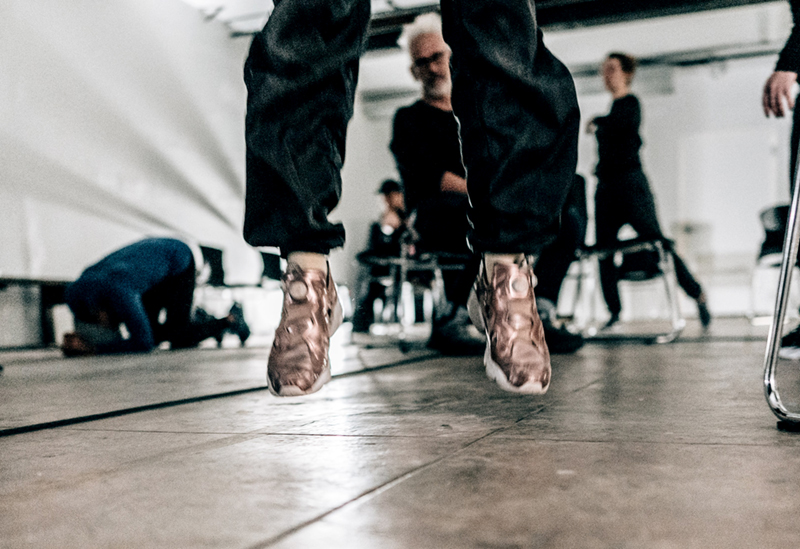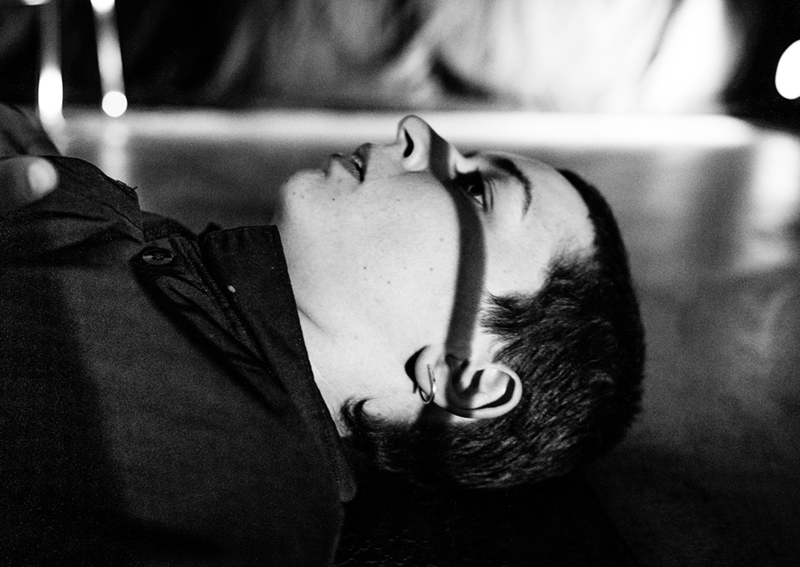Decentering Sight through Dance
An Interview with Jess Curtis, Sophia Neises and Tiffany Taylor
BY EMMALY WIEDERHOLT
Transcontinental choreographer Jess Curtis of Jess Curtis/Gravity recently developed a new work, (in)Visible, which was performed in Berlin this summer and will soon be performed in San Francisco. It seeks to dislocate vision from the center of the experience of dance and focuses specifically on access for blind and visually impaired audiences. Here, Jess and his collaborators Sophia Neises and Tiffany Taylor discuss how the piece is functionally and artistically made accessible and why it’s important to provide audience members other ways of experiencing dance beyond sight.
(in)Visible will be performed Thursday through Sunday, October 3-13 at CounterPulse in San Francisco. Visit www.jesscurtisgravity.org/invisible to learn more.
Photo by Sven A Hagolani
Description: Four people sit onstage, one with a cane. The lighting is red, and a silvery set piece seems to swirl behind them. A dancer is in front of them reaching upward with a stick-like prop in hand. Two people are also seated in the background.
~~
Can you share how (in)Visible came about?
Jess: This particular work comes directly out of my last project with Claire Cunningham, the self-identified Disabled artist from Scotland. We were making an audio description track to make our show more accessible. We did research on best practices around multi-sensory access, and got a grant to work in London at The Place and interview several blind artists and directors, as well as sign language interpreters and audio describers. Through this project, I met Tiffany. I felt like there was a huge amount of research to be done around de-centering vision as the primary mode of experiencing dance. It comes out of my experience loving small theaters or being in the middle of dances. I appreciate different kinds of non-proscenium performance experiences; dance can be such a rich experience when you’re really in the midst of it. When I wrote my PhD, I did a lot of work looking at modes that performances are transmitted through and the phenomenologies of perception that affect performance. Meeting and starting to work with Tiffany brought a lot of those interests together.
Can you describe how the piece has been made accessible to people with visual impairments?
Tiffany: There is audio description as part of the show where we have a describer who works with Gravity Access Services. All the describers are themselves dancers/performers/improvisers. They wear a headset with a microphone that they talk into, and then the blind or visually impaired audience members have headphones where they can hear the description. That service is offered for this show every night, which is rare. Usually there are only a couple shows that offer audio descriptions, maybe five a year in the whole Bay Area, and those are usually big touring productions. And it’s usually only one night of the run that it’s offered. To have it every night is very unusual.
Then, in the show itself, we have artistically built in accessibility. A lot of what the performers are doing is describing what we’re sensing or feeling. We have props, costumes and sound curtains that make noise, so sound is built into the choreography. We also have immersive seating. Audiences can choose to sit on various sides or among the performers. They can also come into contact with the performers if they wish. They’re not just sitting and viewing so, while the show is accessible to blind or low vision people, it’s also changing the perception of dance.
Jess: The whole text of the piece is literally the dancers describing what they’re doing while they’re doing it. This actually comes out of an improvisational training practice I learned from Sara Shelton Mann. We played a lot with various grammarturgy: saying in first person what we’re each doing, working in duets and using second person to describe our partners, or group scores to describe plurally what we are doing. It goes a step beyond accessible to becoming a kind of poetics and aesthetics of access.
Sophia: We also have two nights with ASL interpreters. Some parts of the show are in darkness, so on those nights there will be tiny lights to make the interpreters visible. We also have noted where Deaf audience members should sit to always have access to the interpreter.
From your perspective, what has been the process building (in)Visible?
Sophia: We started with improvisation, saying what we were doing like Jess said. In the beginning, there wasn’t really a structure. There were some parts that Jess had already rehearsed beforehand in December 2018 during a short research time in San Francisco which I was not part of. They brought in that research when we started rehearsing, and I could connect to it.
After a while, we got different materials that made sounds, like curtains, costumes and shoes. We found that some sounds were distracting, while other sounds were more interesting. For example, we had a curtain of wooden beads, but it was too loud. It had to be more precise or gentle. We wanted variations in the soundscape.
In Berlin, the rehearsals always started with a 45-minute improvisation session to keep everything fresh. It was playful how we entered the material. Then we brought in the outside eye.
Jess: We had a two-week research period of December of last year, and then a four-week period in San Francisco where collaborators from Berlin came. Samuel Hertz, the composer from Berlin, joined us in the second research period. His input into the piece and the sounding of the composition gave attention to what different dance movements sound like.
In June and July, we rehearsed in Berlin for six weeks. There, we got to work with our designer, Michiel Keuper, who designed both the costumes and set. It felt like a luxurious research period to fine tune where the sound curtains should go in the space, what the seating configuration should be, who would wear what costume, etc.
Photo by Robbie Sweeny
Desription: Legs in metallic pink shoes jump out of frame on a concrete floor, legs apart. In the background, Jess Curtis looks at the camera through the open legs. Others stand or crawl behind.
Why is it important to tackle this topic now? Can you say more about why this work feels relevant to present today?
Jess: On one level, it’s a social justice issue. Creating access for diverse audiences is really an important thing to give people the opportunity to experience culture. Often, stupid things happen in performance because people aren’t thinking about access. How do older people experience the work? How loud should the music be? Are children going to be in the audience? Thinking more broadly about audiences benefits the work in general and is the right thing to do. There are simple choices that acknowledge what someone other than a completely normative person might need to experience the work. Some of those decisions are easy to implement and allow more people to participate in arts and culture.
Tiffany: Anyone can become disabled, and many people have invisible disabilities or mental health problems. Any attention to disability, like accessible seating or whatever the features might be, goes to educate society in general. We get very negative messages about who can go to dance performances. For example, people often ask me why a blind person would want to go to a dance show. That question stems from the fact that we’ve been conditioned to think that people only watch dance. We’re educating and acknowledging that sight doesn’t have to be the only way of experiencing dance. We want everyone who comes to the show to have an experience, but we don’t pretend that everyone will have the same experience. Whether you’re disabled or not, you’re not going to have the same experience as everyone else. In general, bringing attention to disability and making work that’s accessible is super important, as well as having disabled performers.
How is awareness and accommodation for people with visual impairments different in the Bay Area and Berlin? Is it more common for artists to make their work accessible for visually impaired folks in Europe?
Sophia: It’s just starting in Berlin. I work in a theater that is starting to offer audio descriptions and tours of the space before the performance. Even though we just started doing this in the past year, we’ve suddenly become the experts in Berlin. Everyone is asking us what the best practices are. We take the UK as the best practices example. We use the British Council guidelines for our work, and now people are asking us for those guidelines. So there are steps in Berlin toward access for visually impaired or blind people, but it’s still not that big.
In San Francisco, there’s the Lighthouse for the Blind, an institution doing so much for blind and visually impaired people. We don’t have that in Berlin.
Tiffany: There are more audio descriptions in the UK than in the US. I’m from the Midwest, and there are certainly no audio descriptions there. San Francisco is probably the biggest place to find it, but it’s still rare. This is surprising since the Bay Area was the home of 504, a big disability and independent living movement. There are lots of disability related events, but still very little access practices. It’s surprising how slow progress is.
Jess: Claire Cunningham, Luke Pell and I wrote an article for In Dance comparing the Berlin, Glasgow and San Francisco scenes. In the arts, there’s been major investment in access and diversity in the UK. As a result, there are a lot of good practices as well as some old stodgy practices that people are interested in updating. In Berlin, it’s starting. There’s more cultural support there in general. Sophia is part of a new funding program in Berlin called Making a Difference which provides access to professional training for artists with disabilities. Allowing people to be audience members is only one part of the equation. In the UK, there’s a real class of amazing professional artists who identify as disabled. It’s incredibly enriching. We’re lucky to have AXIS Dance Company in the Bay Area for the past 30 years, but overall there’s less institutional attention. In some ways, the Bay Area and Berlin are at a similar level that’s still learning a lot from places where there’s more developed practices like the UK.
What do you hope audiences take away? Might this work start to change the way that people with sight perceive dance?
Tiffany: We want everyone to have an experience, but we’re not assuming it must be the same experience. Because the performers are immersed in the audience and some might come in contact, there are lots of different experiences possible. The show is not about disability. It’s not only for blind audiences or only about blind dancers.
Sophia: I hope audience members go out with more acceptance of other styles of perception – what they hear, smell, sense. This would be a good outcome for sighted audience members.
Jess: I want to underline that it’s a great show. In Berlin, the more satisfying comments were people coming up and saying we changed the way they experience a performance. It’s not all sensory philosophy though. We have fun, and the performers are an amazing ensemble who I’m honored to work with.
Photo by Robbie Sweeny
Description: Performer Xenia Taniko lies on the floor, a thin rectangular line of shadow falling across the bridge of her nose to her ear. Her mouth is open and her palms rest on her chest. The photo is black and white.
~~
To learn more, visit www.jesscurtisgravity.org/invisible.
Jess Curtis is an award-winning choreographer and performer committed to an art-making practice informed by experimentation, innovation, critical discourse and social relevance. He has created and performed multidisciplinary works throughout the US and Europe with the radical SF performance groups Contraband and CORE and the experimental French Circus company Cahin-Caha. In 2000, he founded his trans-continental performance company, Jess Curtis/Gravity. Jess is active as a researcher, writer, teacher, advocate and community organizer in the fields of contemporary dance and performance. He holds an MFA in Choreography and a PhD in Performance Studies from UC Davis.
Sophia Neises is a Berlin-based performer and teaching artist. In her artistic practice, she works with both “non-professional” performers and internationally acclaimed performance companies such as Zwoisy Mears Clarke and Jess Curtis/Gravity. She currently works as a teaching artist at Sophiensaele and as a project leader for Making a Difference, a program advancing cultural equity for disabled artists in Berlin’s dance scene. Sophia is a visually impaired artist who is pushing the field of performing arts to recognize the necessity and value of diverse bodies in dance and theatre.
Tiffany Taylor is a performer, dancer and singer whose practice is informed by her blindness. She received her BA in Theatre from Adrian college and has studied at the University of Oxford. Tiffany is currently a member of the Berkeley Broadway Singers and has performed at Carnegie Hall. She is a Visual Access consultant for Gravity Access Services where she provides accessibility consultations for performers and venues wanting to make their materials accessible for people with visual impairments. She is a graduate of the Hatlen Center for the Blind where she now teaches Braille to adults with vision loss to help them live independent lives. Tiffany is passionate about the intersectionality of disability and LGBT issues. She sits on the Youth Advisory Council for Youth Organizing Disabled and Proud that organizes and educates disabled youth to advocate for themselves in their community through community organizing campaigns and political activism.




2 Responses to “Decentering Sight through Dance”
Thanks Jimmy! Awesome you could experience their work in person!
Im really glad to see this! I met Jess and Claire Cunningham in New York at a Conference and experienced their Performances. I absolutely LOVED Claire’s Voice and Movement . Jess emits such a Creativity, i found it contagious.
Comments are closed.